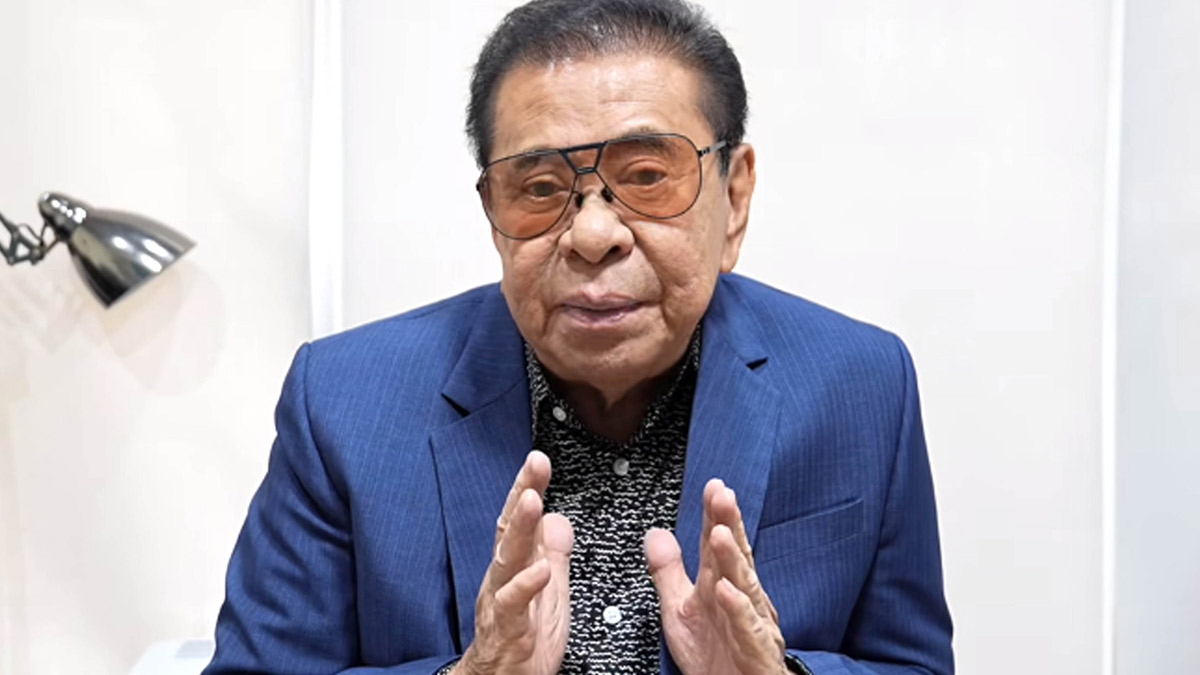💥 “NO ONE EXPECTED THIS!” The Stunning Turn of Events at a Protest That Left Chavit Singson Humiliated and Sparked Unending Public Outrage
Public life in the Philippines has never been short of surprises. Yet, few events have sent shockwaves across the nation quite like the dramatic protest that erupted recently, leaving veteran politician and businessman Chavit Singson in an unprecedentedly awkward position. What began as a routine public demonstration quickly morphed into a nationwide controversy when revelations pointed toward a cause that many never anticipated—one that turned the spotlight directly onto Singson himself.
As the incident unfolded, social media platforms exploded with debate, television programs dissected the details, and millions of Filipinos found themselves glued to their screens. What exactly happened at the protest, and why did it lead to Singson—long regarded as a towering figure in politics and business—being humiliated in front of the nation?

A Protest That Shocked the Nation
The protest in question was initially organized as a demonstration by civic groups raising concerns over governance, transparency, and accountability. While political protests are not uncommon in the Philippines, this particular gathering quickly stood out for its sheer intensity and the caliber of figures it implicated.
Crowds numbering in the thousands converged in the city center, holding banners, chanting slogans, and demanding answers. Television crews broadcast the scenes live, while influencers and citizen journalists flooded Facebook, TikTok, and X (formerly Twitter) with updates. For hours, the protest appeared to follow a familiar pattern—until an unexpected revelation triggered an uproar.
Reports emerged that behind the chaos was a specific decision and involvement linked to Chavit Singson. Almost instantly, the narrative shifted from a generalized call for accountability to a pointed critique aimed directly at him.
The Name That Changed Everything
For decades, Singson has been a prominent figure in Philippine politics and business. Known for his influence in Ilocos Sur, his tenure as governor, and his ventures in various industries—including gaming, construction, and entertainment—his reputation has often been that of a survivor, someone who could weather storms and remain unscathed.
But this time, things were different. The revelation that his name was connected to the uproar acted like a spark on dry grass. Demonstrators, once focused on broader systemic issues, began chanting his name in anger. Placards bearing accusations against him appeared almost instantly, suggesting that organizers or key activists had long harbored suspicions that finally surfaced during the protest.
The chants grew louder, television cameras zoomed in on banners explicitly calling out his alleged role, and suddenly, Chavit Singson was no longer just a bystander to political dissent—he was the epicenter of it.
Humiliation in the Public Eye

What made the situation especially shocking was the public humiliation Singson endured. Known for his charisma and ability to command a room, he was now being lambasted openly in the streets. The once-admiring public appeared divided: some still defended him, but many others joined the chorus of outrage.
Videos circulated showing protestors mocking him, memes were created within minutes, and hashtags trending on social media painted him in an unflattering light. In a society where public image can make or break a legacy, the damage was instantaneous and profound.
For someone of Singson’s stature, who has long cultivated an aura of strength and authority, the sight of crowds condemning him was nothing short of devastating. Observers noted that it was the first time in years that his control over the narrative slipped so dramatically.
Social Media: A Firestorm of Reactions
No modern political scandal is complete without the wildfire of social media. Within hours, the protest and the role attributed to Singson became the top trending topic across platforms.
On Facebook, live videos of the protest were shared tens of thousands of times, with comments ranging from outrage to disbelief.
On X, hashtags like #ChavitExposed, #ProtestChaos, and #AccountabilityNow surged to the top of the trends.
On TikTok, creators produced short, biting commentary clips, blending protest footage with satirical overlays that quickly garnered millions of views.
Public opinion was anything but uniform. Some users expressed shock and disappointment, others defended Singson as a scapegoat, and still more demanded immediate investigations. Regardless of perspective, one thing was clear: everyone was talking about Chavit Singson.
Political and Public Backlash
The fallout from the protest was swift. Opposition leaders seized the opportunity to criticize Singson, framing the incident as evidence of deeper problems within the country’s governance. Editorials in major newspapers questioned his role, demanding explanations. Even longtime allies appeared hesitant to defend him outright, fearing the tidal wave of backlash might engulf them too.
Ordinary citizens voiced frustration in interviews broadcast on evening news programs. One protester declared, “We never expected his name to come up. But now that it has, we deserve the truth. He owes us answers.”
This collective demand for accountability created a rare moment of unity among disparate groups: activists, political commentators, and everyday Filipinos alike.
The Larger Questions Raised
While the controversy undeniably centered on Chavit Singson, it also raised larger questions that extended beyond one man. The protest, after all, was about governance and accountability. Singson’s involvement—whether direct, indirect, or perceived—became a symbol of broader frustrations.
Why do the same names surface repeatedly in Philippine politics? Why do allegations often linger unresolved, only to resurface years later? And how does public trust erode when leaders appear entangled in scandal after scandal?
These questions amplified the drama, ensuring that the protest’s impact went far beyond a single day’s headlines. It became a national conversation about integrity, power, and the price of public service.
Singson’s Response
Faced with mounting pressure, Singson eventually released a statement. Calm but defensive, he denied wrongdoing and dismissed the allegations as politically motivated. He framed the protest as an orchestrated attempt to damage his reputation, insisting that the truth would vindicate him.
Yet the tone of his response did little to quell the firestorm. Critics argued that it lacked substance and failed to address the specifics of the accusations. Supporters, however, praised his composure, saying he was right to avoid engaging in what they saw as baseless attacks.
Still, the undeniable reality was that his image had already taken a massive hit.
The Impact on His Legacy
Chavit Singson’s name is synonymous with survival in Philippine politics. From controversies in the past to his high-profile alliances, he has always managed to bounce back. But the protest humiliation represented something new: a public spectacle of rejection.
Historians and political analysts alike suggested this could mark a turning point in how he is remembered. Instead of solely being regarded as a seasoned leader and businessman, he might now also be remembered as the man who faced one of the most humiliating public moments in modern political history.
For someone whose career has spanned decades, the protest underscored a painful reality: legacies can change in an instant.
Public Divisions: Forgiveness vs. Accountability
As with any scandal involving a powerful figure, the public has split into camps. Some argue that everyone deserves forgiveness and that decades of service should not be erased by a single controversy. Others believe that accountability must come first, regardless of past achievements.
This debate has played out in comment sections, radio call-in shows, and even family dining tables. It reflects the complexity of Filipino society, where personal loyalty, political affiliation, and a deep cultural emphasis on respect for authority often clash with the demand for transparency and reform.
Looking Ahead: What Comes Next?
The immediate future for Chavit Singson remains uncertain. Legal investigations could follow if formal complaints are filed, while political rivals may attempt to capitalize on his vulnerability. Meanwhile, his business interests could also feel the ripple effects as partners reconsider associations.
But perhaps the most significant challenge lies in rebuilding public trust. Once shaken, it is notoriously difficult to restore—especially in the age of social media, where memories are long, and receipts are permanent.
For now, the protest and its fallout stand as a stark reminder that even the most powerful figures are not immune to public scrutiny and humiliation.
Conclusion: A Turning Point in Philippine Showbiz-Politics?
The incident involving Chavit Singson will likely be studied for years as an example of how quickly fortunes can change in the Philippines’ turbulent political and entertainment landscape. What began as a routine protest became a flashpoint for national debate, dragging a prominent figure into the spotlight in the most unflattering way possible.
“No one expected this,” indeed. In a single day, a man who had long epitomized power and survival found himself at the center of the storm—mocked, criticized, and humiliated before millions.
Whether this moment proves to be the greatest setback of his career or yet another storm he weathers will depend on how he responds in the weeks and months ahead. But one thing is certain: the protest has left an indelible mark on both his legacy and the national consciousness.





